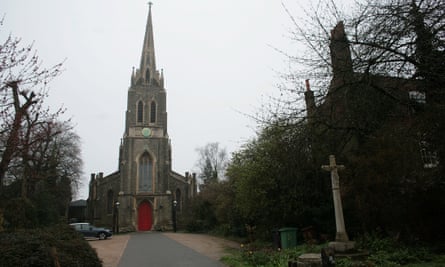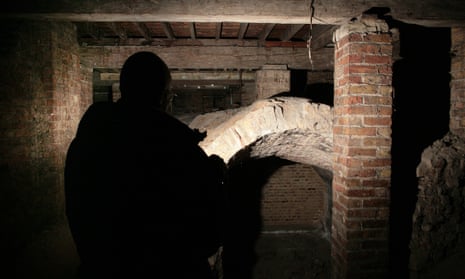It probably wouldn’t have surprised his long-suffering friends, but the remains of the poet Samuel Taylor Coleridge have been rediscovered in a wine cellar.
Literary pilgrims have long paid their respects at the memorial plaques to Coleridge in the church above, unaware his lead coffin was lying behind a brick wall closing one end of the 17th-century cellar. The space was incorporated into the crypt of St Michael’s when the church was built in 1831 near the top of Highgate Hill in north London.
“It has been said that you could see it as appropriate, but it is not in a very fitting state for him, and the family would support the plans to improve it,” said Richard Coleridge, the poet’s great-great-great-grandson, a police officer based in Newham.
Coleridge’s well preserved lead coffin is just visible through a ventilation brick, together with those of his wife, Sara, his daughter, also Sara, his son-in-law and his grandson.

The church plans to clear and restore the crypt – which is still half full of rubble from the demolished mansion, Ashhurst House, that preceded the church – and allow access to the last resting place of one of the most renowned English poets.
At present the only way of visiting it is to go down a flight of stairs, through a door and then to clamber over and around piles of bricks and dust.
“From a safety point of view it would be quite impossible to bring members of the public down here,” said the vicar, Kunle Ayodeji. “But we hope that the whole crypt can be cleared as a space for meetings and other uses, which would also allow access to Coleridge’s cellar. I don’t think we would open up a view of the coffins, but we could place a suitable inscription on the wall.”

Coleridge, author of The Rime of the Ancient Mariner, and Kubla Khan, was a genius who suffered from poor health and depression. A heavy drinker, he also became addicted to opium in the form of laudanum originally prescribed for his health, and died aged 61 in July 1834.
Coleridge could see the distinctive red door of the handsome new church from his last home across the green, where he lodged with a doctor he hoped could cure him – a house now owned by the model Kate Moss. He was buried in the nearby chapel of Highgate school. In 1961 it was noted that Coleridge’s vault had become derelict, and after an international fundraising appeal the coffins were moved to St Michael’s, with the poet laureate John Masefield giving an address at the unveiling of the stone.
But in the words of Drew Clode, a member of the St Michael’s stewardship committee, “poor Coleridge was moved from a tip to a tip – they put the coffins in a convenient space which was dry and secure, and quite suitable, bricked them up and forgot about them, and never did anything about the rest of the space”.
As people died or moved away from the parish, the exact location of the coffins was forgotten, until a recent excavation revealed the entrance to the wine vault. The gap was just large enough to shine a torch through the ventilation block in the 1960s brick wall, and the excavators discovered the five lead coffins. They lay not where most thought, in the far corner of the crypt, but almost directly below the inscription “Beneath this stone lies the body of Samuel Taylor Coleridge” on the prominent memorial slab in the nave. “So that was a bit of a clue really,” said Clode.
The church is planning a special Coleridge day in June with recitals and lectures, with several members of his family expected to be present, to raise funds towards the restoration project.








